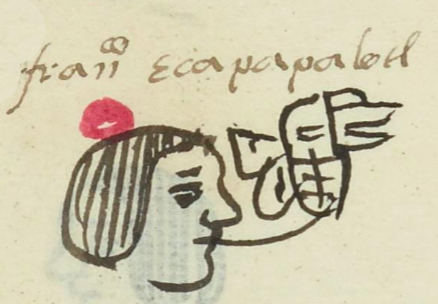Ecapapalotl (MH566v)
This black-line drawing of the compound glyph for the personal name Ecapapalotl (“Air-Butterfly,” attested here as a man’s name) shows a profile view of a butterfly (papalotl), facing toward the viewer's right. The butterfly has two wings and a thick body. Attached to the head is an Ehecatl (deity or divine force of the wind) mask.
Stephanie Wood
Gabrielle Vail and Christine Hernández (Re-Creating Primordial Time, 2013) describe Ehecatl as the wind aspect of Quetzalcoatl, and they note that Ehecatl "wears a buccal (duck) mask through which to blow wind." That the "beak" may have been perceived as a blowing device is supported by the glyph for Pitztli (below).
Ecatl (air, breath) is a word of its own, but it is also used sometimes as a short version of Ehecatl, which has the reduplication of the first syllable, apparently changing it to "wind." A great many glyphs in this collection start with Eca- when one might expect Eheca-. We are preserving the proclivity of the gloss for Eca-, while also pointing to the likelihood of an unintentional oral abbreviation of Eheca- to Eca-.
John Montgomery drew a group of wind glyphs (possibly mainly Mixtec), showing the variety of ways the blowing device might look. It is published in FAMSI, Inc.
Butterflies are significant in Nahua culture. There were butterfly songs, butterflies flew down from the top of the pole in the Volador event. Butterfly wing movement was equated with the patting of corn dough into tortillas. Obsidian was carved into butterflies. Capes had butterfly designs. See our Online Nahuatl Dictionary.
Stephanie Wood
franco Ecapapalotl
Francisco Ecapapalotl
Stephanie Wood
1560
Jeff Haskett-Wood
butterflies, mariposas, wind, viento, deidades, deities, divine forces, fuerzas divinas, aire, aliento

eca(tl), breath, air, https://nahuatl.wired-humanities.org/content/ecatl
Ehecatl, wind, or the divine force of the wind, a deity, https://nahuatl.wired-humanities.org/content/ehecatl
papalo(tl), butterfly, https://nahuatl.wired-humanities.org/content/papalotl
Aire o Viento-Mariposa
Stephanie Wood
Matrícula de Huexotzinco, folio 566v, https://www.loc.gov/resource/gdcwdl.wdl_15282/?sp=212&st=image
This manuscript is hosted by the Library of Congress and the World Digital Library; used here with the Creative Commons, “Attribution-NonCommercial-ShareAlike 3.0 License” (CC-BY-NC-SAq 3.0).







